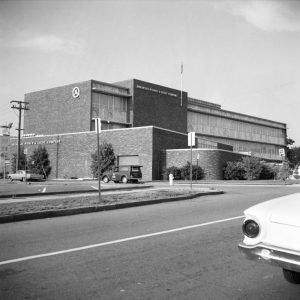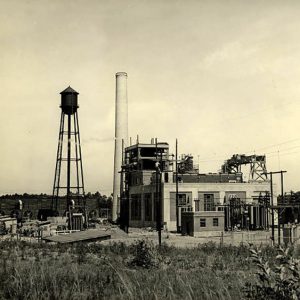calsfoundation@cals.org
Arkansas Power and Light (AP&L)
The Arkansas Power and Light Company (AP&L) was the primary electrical utility company for much of Arkansas from 1913 to 1989. It was the predecessor to Entergy Corporation, the electrical company now serving much of the state in the twenty-first century.
The company was founded in 1913 as the Arkansas Power Company by Harvey Crowley Couch, a native of Columbia County and a successful railroad and telephone utility entrepreneur. In 1914, Couch bought the power plants at Arkadelphia (Clark County) and Malvern (Hot Spring County) and then built a twenty-two-mile electrical transmission line running between them. The system had problems with electrical supply and ran exclusively at night, but it served as the only electrical transmission line in the state. Couch quickly struck a deal with H. H. Foster, owner of the Arkansas Land and Lumber Company, to acquire excess sawdust. The sawdust would be burned to power his two 550-kilowatt generators. Couch proceeded to rechristen the company Arkansas Power and Light Company by the end of 1914. Although a number of Arkansas communities were already starting to offer electrical service locally, AP&L became a pioneer in the state by offering reliable service between cities.
As Couch expanded the reach of AP&L through the purchase of additional lines and competing providers, he began to develop more effective means of electrical generation. He began working with Arkadelphia businessman and steamboat captain Flavius J. “Flave” Carpenter in 1916 to explore possible sites for hydroelectric dams along the upper Ouachita River. Arkansas lumber executive Harmon L. Remmel proceeded to help Couch secure the permits from the federal government to build the dams. Grateful for his assistance, Couch named the first of these dams Remmel Dam, which was completed in December 1924. The dam, between Malvern and Hot Springs (Garland County), not only provided more power for the growing demand of AP&L customers but also created the 1,940-acre Lake Catherine, named after Couch’s daughter. In 1929, construction on Carpenter Dam began, named after Flave Carpenter. The dam was completed in 1931, creating the 7,200-acre Lake Hamilton, named for AP&L counsel Colter Hamilton “Ham” Moses, just outside Hot Springs. Not only did these projects provide vital power for the growing AP&L customer base, but the two lakes have also become recreational landmarks.
As the utility’s success grew in the 1920s, Couch moved to create similar electrical utility giants in neighboring Mississippi (Mississippi Power and Light, or MP&L) and Louisiana (Louisiana Power and Light, or LP&L). By 1930, AP&L had customers in more than sixty Arkansas counties and owned 3,000 miles of transmission lines.
In 1935, President Franklin D. Roosevelt enacted the Rural Electrification Administration (REA) to bring electricity to rural areas. Many rural areas in Arkansas still lacked access to electricity by the late 1930s. The REA supported efforts to create local electrical cooperatives to speed up electrification. While Couch had been supportive of rural electrification, AP&L balked at the co-op approach and insisted that federal grants and loans for rural power be funneled through AP&L directly. This fight with the REA would diminish after World War II as farmers and planters in eastern Arkansas worked with local co-ops and AP&L to further develop power systems. However, AP&L officials would continue to clash with the REA, various state and local officials, and particularly Governor Sid McMath in the 1950s over promoting the local co-ops.
Couch died in 1941, and Ham Moses became AP&L president, serving in the position until 1952. Moses continued Couch’s policies of using the utility to promote industrial development in the state and remained as chairman of the board for AP&L until his retirement in 1955.
In 1949, AP&L (along with LP&L, MP&L, and the New Orleans, Louisiana, public utility provider New Orleans Public Service, Inc.) was brought under the newly organized umbrella corporation Middle South Utilities. The corporate headquarters would relocate from Pine Bluff (Jefferson County) to New York and remain there until moving to New Orleans, Louisiana, in 1975.
The late 1960s and the 1970s was a time of innovation for AP&L as more advanced generation technologies became available and instability in the oil supplies of the Middle East made its power an increasing economic necessity. In 1967, the utility announced that it would build the state’s first nuclear reactor, near Russellville (Pope County). Arkansas Nuclear One Unit 1 was completed in December 1974. The pressurized water reactor can produce 836 megawatts of electricity. Less than six years later, the sister reactor, Arkansas Nuclear One Unit 2, reached completion, capable of producing 987 megawatts of power. Together, the two reactors could fulfill almost one-third of the state’s total electrical needs. Together, they ultimately employed 900 people. In 1980, the White Bluff station near Pine Bluff became the first coal-powered electrical plant in the AP&L system.
In the early 1980s, AP&L ran into controversy with the deregulation of the state’s public utilities and what came to be known as the “Grand Gulf affair.” In 1982, Governor Frank White abolished the Arkansas Department of Energy and allowed the company to impose a $104 million rate hike on consumers. In 1984, the Grand Gulf affair erupted when the Federal Energy Regulatory Commission (FERC) assigned AP&L a greater share of construction costs than other utilities. The Arkansas Public Service Commission then authorized a settlement that obligated AP&L to pay eighty percent of the construction costs of the Grand Gulf Nuclear Station in Port Gibson, Mississippi, further increasing electrical rates. Once the station was completed in 1985, Grand Gulf would provide electricity only for residents of Mississippi. The resulting public relations firestorm resulted in one state legislator briefly threatening the utility with a state takeover.
In 1989, Middle South Utilities changed its name to Entergy Corporation. AP&L continued as the division Entergy Arkansas. This successor corporation continued to expand, acquiring Gulf States Utilities, the electrical provider for most of southeast Louisiana and southeast Texas, in 1993.
By 2011, Entergy had 30,000 megawatts (30 billion watts) of generative capacity and 15,500 miles of transmission lines. The division Entergy Nuclear owns or operates twelve nuclear power units: the two reactors in Russellville; two stations in Louisiana; three stations in New York; and reactors in Massachusetts, Michigan, Mississippi, Nebraska, and Vermont. By this time, Entergy also owned or operated twenty-nine other non-nuclear power plants, utilizing either natural gas, oil, coal, or hydroelectric generation. The company supplied electricity for 2.8 million customers in the four-state service area.
Entergy Arkansas employs approximately 3,500 people in the state and provided electrical power for approximately 693,000 customers in sixty-three of the state’s seventy-five counties.
In August 2015, in response to a federal Environmental Protection Agency plan to reduce pollution, Entergy Arkansas proposed to close the White Bluff plant by 2028 rather than install expensive scrubbers.
In October 2022, Entergy announced plans to build Arkansas’s largest solar facility, covering 2,100 acres south of Osceola (Mississippi County). The facility will provide energy for U.S. Steel operations in Mississippi County.
For additional information:
Entergy. http://www.entergy.com/ (accessed October 5, 2022).
Johnson, Ben F. Arkansas in Modern America since 1930. 2nd ed. Fayetteville: University of Arkansas Press, 2019.
Laymon, Sherry. “Arkansas’s Dark Ages: The Struggle to Electrify the State.” Arkansas Historical Quarterly 71 (Autumn 2012): 283–300.
Moneyhon, Carl H. Arkansas and the New South, 1874–1929. Fayetteville: University of Arkansas Press, 1997.
Moreau, Andrew. “Entergy Solar Project Will Be State’s Largest.” Arkansas Democrat-Gazette, October 5, 2022, 1D, 4D. Online at https://www.arkansasonline.com/news/2022/oct/05/entergy-solar-project-will-be-states-largest/ (accessed October 5, 2022).
Olson, James S. “Harvey C. Couch and the Reconstruction Finance Corporation.” Arkansas Historical Quarterly 32 (Autumn 1973): 217–225.
Wilson, Stephen. Harvey Couch: An Entrepreneur Brings Electricity to Arkansas. Little Rock: August House, 1986.
Wilson, Winston P. Harvey Couch: The Master Builder. Nashville, TN: Broadman Press, 1947.
Kenneth Bridges
South Arkansas Community College
 WOK
WOK AP&L Offices
AP&L Offices  AP&L Shop
AP&L Shop  Arkansas Nuclear One
Arkansas Nuclear One  Arkansas Power & Light (AP&L) Ad
Arkansas Power & Light (AP&L) Ad  Carpenter Dam
Carpenter Dam  Coal Train
Coal Train  Couch Power Plant in Stamps
Couch Power Plant in Stamps  Harvey Couch with Will Rogers
Harvey Couch with Will Rogers  Lake Catherine Power Station
Lake Catherine Power Station  Lake Catherine Power Station
Lake Catherine Power Station  J. Leland Longino
J. Leland Longino  Ham Moses
Ham Moses  Ham Moses
Ham Moses  Mountain Home AP&L Office
Mountain Home AP&L Office  Remmel Dam Power Station
Remmel Dam Power Station  White Bluff Station
White Bluff Station 



Pine Bluff was in essence the base of operations where Harvey Couch built his life and legacy. Couch is listed as “Ward 2” resident of Pine Bluff in the 1920, 1930, and 1940 census records. In addition, the Arkansas Light & Power Company is listed at 411 S. Main in the 1922 city directory and as Arkansas Power and Light at the same address in the 1927 city directory available online at the Jefferson County Library’s website. The 1953 directory lists Arkansas Power & Light’s “general offices” at Sixth and Pine (site of PBSD Administrative offices). Couch was also listed as president of the Pine Bluff Chamber of Commerce, evidence of his strong ties to the community.